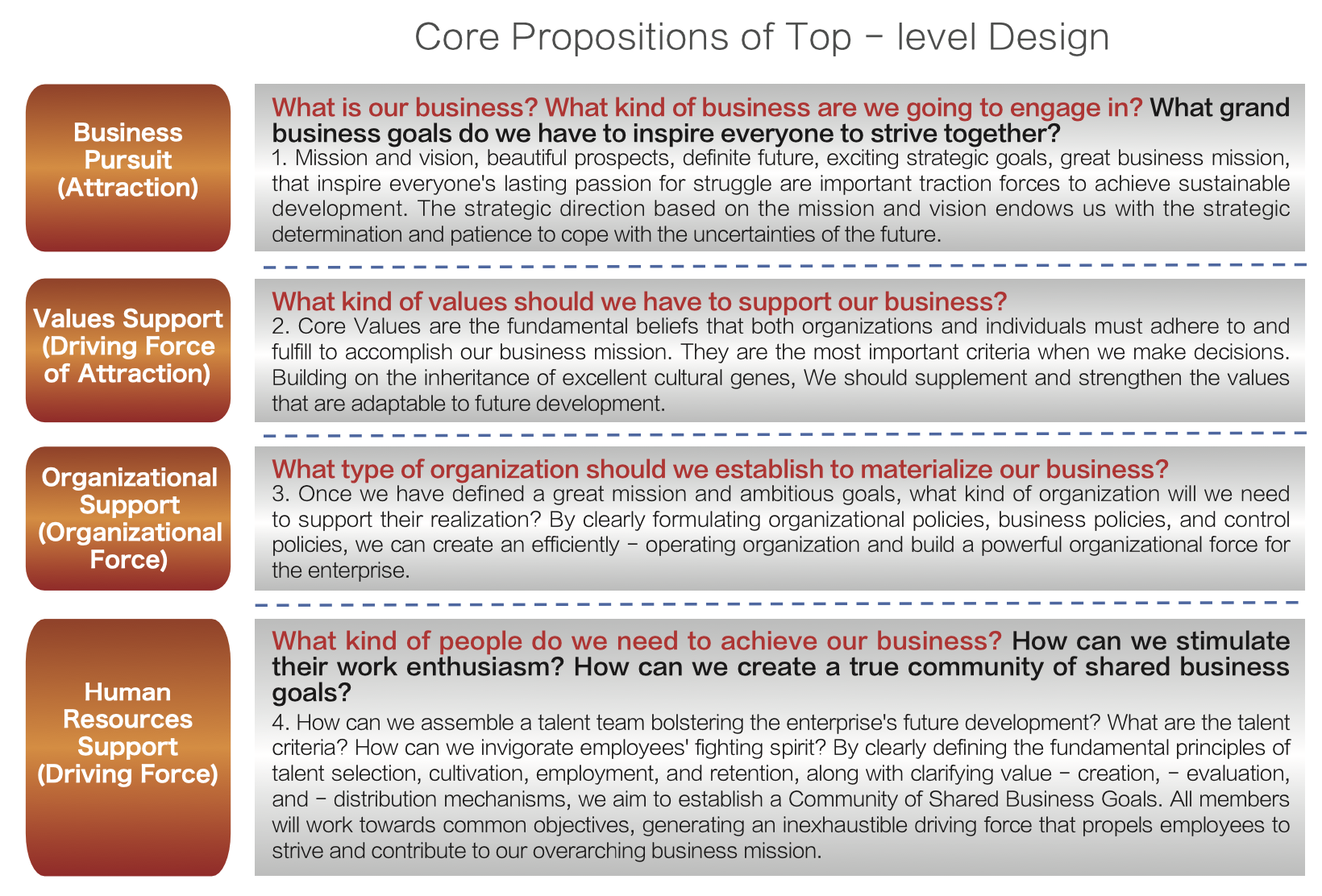What Is Top-Level Design?
"Top-Level Design" is Chinastone's original classic consulting service solution. Based on the solution, Chinastone's perspective on top-level design is as follows:
Ō¢Č Top-level design is an integrated system of values for enterprises pursuing future sustainable development and excellence. It is a basic assumption system based on business theory, strategy implementation, and operational propositions, reflecting the correct expression system of a company's mission, pursuit, and long-term value orientation. It is the "strategy behind the strategy."
Ō¢Č Top-level design is the premise and starting point of corporate culture building. Under the guidance of the integrated value system and basic assumption system, it involves rational thinking and team consensus on fundamental strategic propositions such as corporate governance, resource allocation, organizational development, talent policies, risk control, and stakeholder relationships. It serves as the ideological foundation and action guide for various specific business and management decisions, often referred to as the "compass behind management."
What Problems does Top-Level Design Solve?
Ō¢Č Resolves the ultimate source of motivation for long-term team struggle, such as corporate mission and vision.
Ō¢Č Defines the business domain and growth methods of the enterprise.
Ō¢Č Helps entrepreneurs and senior leadership teams complete systematic future-oriented thinking and achieve self-transcendence.
Ō¢Č Helps entrepreneurs and senior leadership teams reach cultural and strategic consensus, building leadership based on cultural values.
Ō¢Č Completes the key drivers of strategic success and resource allocation principles.
Ō¢Č Completes the design of organizational and talent mechanisms.
Ō¢Č Builds the enterprise management system and the path for future development.
Ōś× Chinastone Emphasizes
Top-level design requires deep participation from top executives. The process of top-level design is more important than the outcome. It highlights the role of collective wisdom and strategic leadership, as strategic execution begins with consensus. Collective wisdom is more important than individual wisdom.
The main expressions of top-level design consulting achievements include documents such as the Huawei Basic Law, OCT Charter, Midea Cultural Guidelines, Lenovo Cultural Research, and Suning Cultural Reshaping and Entrepreneurial Thought Research.
What Is Corporate Culture?
Corporate culture building and cultural management are Chinastone's original branded consulting projects, represented by the Huawei Basic Law, with multiple original research-based consulting achievements.
Chinastone's Perspective on Corporate Culture:
Ō¢Č Corporate culture is the unique way a company operates and the value beliefs behind these practices!
Ō¢Č Corporate culture should be integrated with business operations, forming a series of management practices developed during the company's growth, not just slogans or slogans.
Ō¢Č Corporate culture is the soul of an enterprise, guiding the formulation of policies aligned with its values. It is the guiding ideology behind corporate systems and processes, the way of business and management.
Corporate Culture Building Solutions
(1) Top-level design and value system review. Expressions include corporate culture outlines, corporate basic laws, and corporate culture manuals.
(2) Value-based corporate culture management system building. Focuses on "management," aligning corporate culture with company strategy, human resources, production, operations, marketing, and other management modules to enhance quality, efficiency, and sustainability. Expressions include "value-based management optimization models and solutions."
(3) Values and cadre talent team building. Values are the ultimate standard for judging and screening employee behavior. Building a cadre talent team with shared values is the premise for achieving long-term success. Chinastone believes corporate values should translate into standards for identifying and evaluating employees' character, attitude, vision, and mindset. Expressions include "striver culture and cadre team building."
(4) Culture implementation projects. These projects rely on top-level design and value building to transform corporate culture concepts into behaviors widely followed by employees. Expressions include employee behavior manuals, culture case collections, culture training manuals, and culture ritual activities.
Ōś× Chinastone's Perspective on Culture
ŌŚÅ Culture is a belief, a mission pursuit that inspires passion, potential, and creativity.
ŌŚÅ Culture is a stance, a value position, and a standard for judgment, fostering rationality and bottom lines.
ŌŚÅ Culture is an assumption, a correct future business hypothesis that guides organizations and individuals, creating traction.
ŌŚÅ Culture is consensus, unifying thoughts, establishing common language, reducing transaction costs, and fostering cohesion.
ŌŚÅ Culture is a habit, the unique thinking and behavior of an organization, requiring inheritance and innovation.
ŌŚÅ Culture is a contract, elevated to a psychological contract between the organization and individuals, enabling self-management and self-discipline.
Consulting Achievements in Top-Level Design and Corporate Culture Building
01. Corporate culture diagnosis
02. Entrepreneurial thought extraction, management, and application
03. Corporate culture outline (corporate culture expression system)
04. Value evaluation standards
05. Value-based cadre talent system building plans
06. Corporate culture interpretation collection (corporate culture dictionary)
07. Corporate culture case collection
08. Corporate culture building planning solutions
09. Corporate culture and brand management strategies
10. Corporate culture and social responsibility reports
11. Corporate culture and leadership training enhancement plans
12. Corporate culture and new employee training plans and tutorials
13. Corporate culture theme day designs (e.g., quality culture, cost-saving, team collaboration, customer service, etc.)
14. Corporate culture and cadre mission, responsibility, and capability building
15. Core corporate values and customer-centric organizational process optimization
16. Culture value-based organizational change
17. Corporate honor system building

